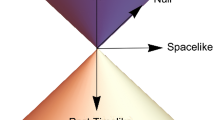Abstract
Bell's theorem applies only to a hybrid universe in which hidden variables determine only part of the outcomes of experiments. When applied to a fully causal hidden variable theory, in which detector settings as well as their interaction with particles during observation are determined by the variables, Bell's analysis must be modified. The result is that a fully causal hidden variable model can be produced for which a properly chosen spread of hidden variables gives precisely the same prediction as standard quantum theory.
Similar content being viewed by others
References
Bell, J. S. (1964).Physics,1, 195.
Bell, J. (1981).Journal de Physique, Colloque C2 (Suppl. 3),42, 57.
Clauser, J. F., and Shimony, A. (1978).Reports on Progress in Physics,41, 1881.
Finkelstein, D. (1987). InEncyclopedia Britannica Yearbook of Science, p. 186.
Mermin, N. (1985).Physics Today 38, 38.
Peres, A. (1978).American Journal of Physics,46, 745.
Stapp, H. P. (1980).Foundations of Physics,10, 767.
Author information
Authors and Affiliations
Rights and permissions
About this article
Cite this article
Brans, C.H. Bell's theorem does not eliminate fully causal hidden variables. Int J Theor Phys 27, 219–226 (1988). https://doi.org/10.1007/BF00670750
Received:
Issue Date:
DOI: https://doi.org/10.1007/BF00670750




